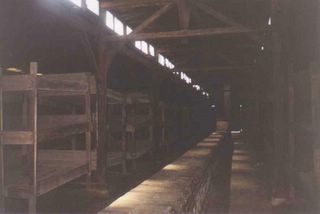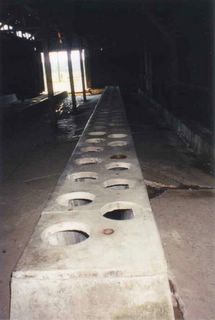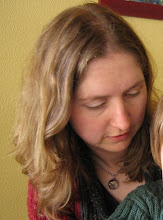Although the new bigger camp was crude and unfinished, the design was chillingly effective. Train tracks lead to a 'selection' area and then on to the 'showers' which, along with the crematoria, were underground. The guide told us that when the death camp was in operation, all that could be seen on the surface was grass and flowers and a little white building. People heading for the 'showers' would have been naïve not to expect that something was up, but I don't know how many would have imagined the truth.
When the newcomers arrived at their destination, officially known as Bunker No. 1, they saw two neat little farmhouses, with thatched roofs and whitewashed walls, surrounded by fruit trees and shrubbery.
Otto Friedrich (1994): The Kingdom of Auschwitz, p 31.
The gas chambers and crematoria at Birkenau, much bigger than the experimental ones at Auschwitz I, were destroyed by the Nazis as they retreated.


Barracks.

Toilets.

At the time I though it was an anticlimax to be there. It was very moving, but didn't quite hit home. Just a place. You need the information, and the imagination, and the fear and the horror, to make it real in your mind. Just a place, where some people did unthinkable things to other people. Being there and seeing the wood and the brick and wire of it actually mades it, paradoxically, a little harder to really believe.
At Auschwitz I stood in a room where hundreds of people were gassed, an early prototype for the purpose-built gas chambers at Birkenau. In an adjoining room we saw the remains of an oven where those bodies were cremated. But these are now just rooms in a museum. I've since realised that that ordinariness - just buildings and rooms - is important. It means that evil can be done anywhere. Thinking of the Nazis as devils or automatons following orders can lead you to miss the point that it was just people (with families and pets and all) who did these things. It's not really a careless choice of costume that we ought to be watching out for. It's a dozen less visible, and more isidious events that happen every day.
On the bus going back to Krakow I heard Bananarama. I think it was the same driver, though it was a more comfy bus.
Auschwitz Memorial and Museum
Yad Vashem, Jerusalem
about the Holocaust

No comments:
Post a Comment